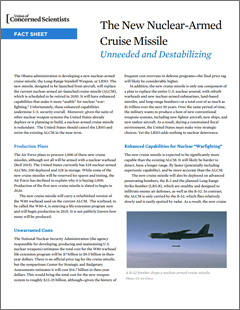In 2010, President Obama declared that the United States “will not pursue new military missions or new capabilities for nuclear weapons.” Yet despite this assurance—and despite earlier promises to reduce “the role of nuclear weapons in our national security strategy”—the Obama administration then proposed a new nuclear-armed cruise missile, dubbed the “Long-Range Standoff” weapon, or “LRSO.”
Designed for aircraft, the LRSO is meant to replace an existing nuclear-armed cruise missile currently slated for retirement, and will have enhanced capabilities that make it more “usable” for nuclear warfighting. It will likely be harder to detect, have a longer range, fly faster, and be more accurate than the weapon it’s replacing. It will also be usable across a range of aircraft; the current missiles can only be launched from the relatively slow-flying B-52, while the LRSO will be deployed across several advanced bombers.
“Better” doesn’t mean “safer”
While the LRSO may boast a wider range of capabilities than its predecessor, those capabilities will not make the United States safer. Instead, the missile will offer US military planners a tool for nuclear war-fighting, increasing the likelihood of nuclear use.
By expanding the number of scenarios in which nuclear weapons play a role, constructing the LRSO would represent a profound shift away from nuclear deterrence, the longtime cornerstone of US security strategy. In the words of former secretary of defense Bill Perry and former Pentagon official Andy Weber, such a shift “is Cold War thinking, and it is dangerous. Such ‘tactical’ use of nuclear weapons would be a grave mistake.”
New hardware also comes with a cost: the nonpartisan Center for Strategic and Budgetary Assessments estimates the LRSO, together with the updated warhead it will use, will cost more than $20 billion in taxpayer dollars. Cancelling the LRSO would avoid this needless expenditure and help prevent the United States from further destabilizing an already-fragile international security system.




